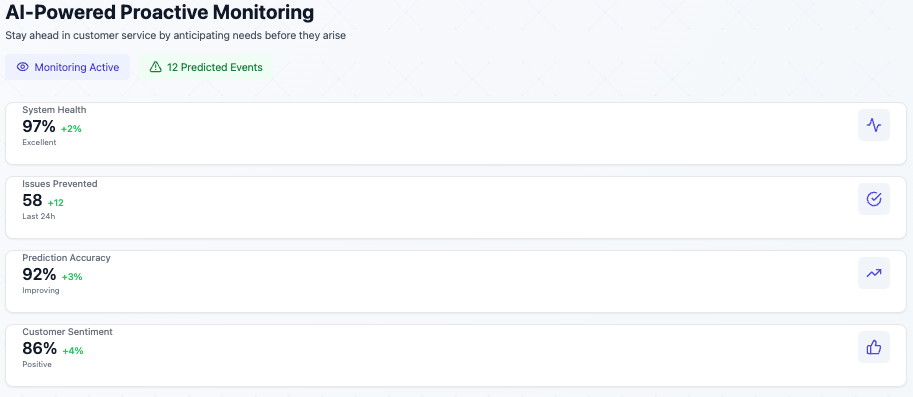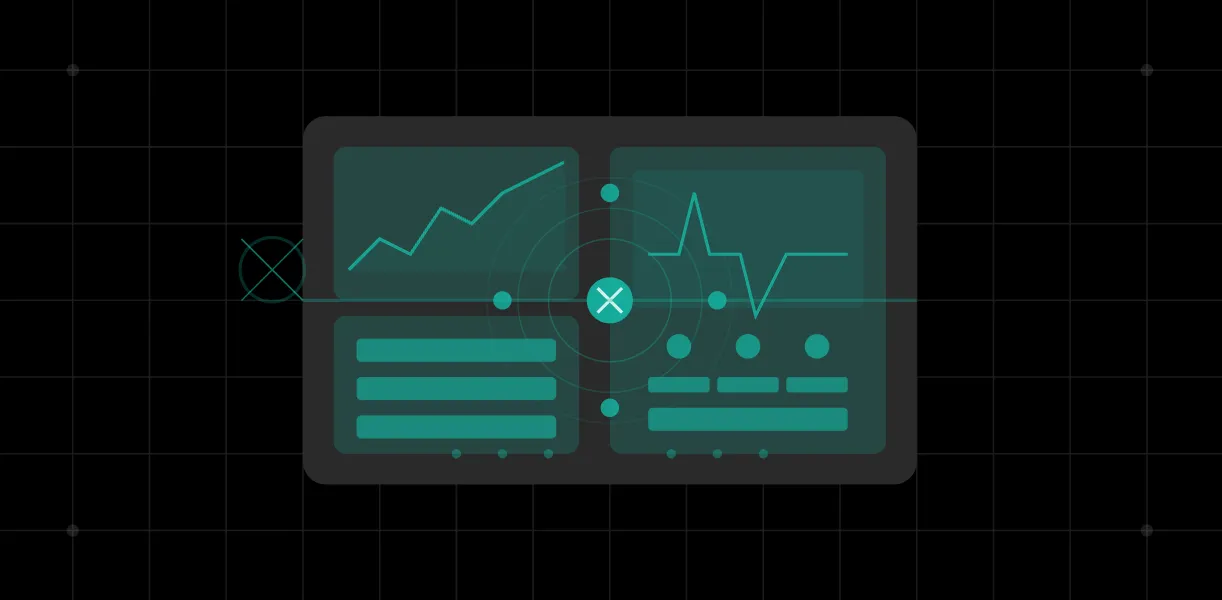AI Powered Proactive Monitoring: Stay Ahead in Customer Service Today
AI Powered Proactive Monitoring: Stay Ahead in Customer Service
In the customer service landscape, the reactive model of waiting for customers to report problems is becoming outdated. Forward-thinking businesses are now using AI-powered proactive monitoring to anticipate customer needs and fix issues before customers even notice them. By understanding and analyzing customer behaviors, businesses can foresee potential issues and address them proactively. This shift from reactive to proactive customer service is one of the biggest changes in how businesses interact with their customers.

The Evolution of Customer Service
From Reactive to Proactive
The traditional reactive approach to customer service is no longer sufficient in today’s fast-paced, digitally-driven world. Customers expect prompt, personalized, and proactive support that anticipates their needs and resolves issues before they escalate. This shift towards proactive customer service requires a fundamental transformation in how businesses approach customer interactions.
Proactive customer service involves using data and analytics to anticipate customer needs, identify potential issues, and provide personalized solutions before customers even reach out for help. This approach not only improves customer satisfaction but also reduces the volume of support inquiries, leading to cost savings and increased efficiency.
The Role of Artificial Intelligence in Customer Service
Artificial Intelligence (AI) plays a crucial role in enabling proactive customer service. AI-powered tools can analyze vast amounts of customer data, identify patterns and trends, and provide personalized recommendations and solutions. AI-driven chatbots and virtual assistants can engage with customers in real-time, providing instant support and resolving issues quickly.
Moreover, AI can help businesses anticipate customer needs by analyzing customer behavior, preferences, and feedback. This enables businesses to proactively address potential issues, improve customer satisfaction, and build loyalty.

The Strategic Advantage of Being Proactive
Customer service has always been fundamentally reactive: a customer hits a problem, contacts support and waits for resolution, necessitating adaptive customer service strategies. This approach puts businesses on the back foot, scrambling to fix issues after customer satisfaction has already been impacted. Customer service agents, equipped with AI tools, can provide more effective and proactive support, enhancing overall customer satisfaction.
Proactive monitoring flips this. By using AI to continually analyze patterns, predict potential issues and take preventative actions, businesses can prevent problems rather than just solve them. This forward thinking approach gives numerous strategic advantages that are redefining customer service across industries.
Key Drivers of Adoption
Better Customer Experience Through Anticipation
The biggest benefit of AI-powered proactive monitoring is the ability to transform the customer experience. By mapping out the customer journey, businesses can identify pain points and enhance overall engagement. By predicting customer needs and potential issues before they happen, businesses can:
-
Fix problems before customers get frustrated
-
Provide personalized support based on anticipated requirements
-
Give the impression of being attentive, almost prescient
This anticipatory approach creates amazing customer experiences that feel bespoke and super responsive.
Huge Reduction in Support Costs
The financials of proactive monitoring are significant. Research shows time and again that preventing issues is much cheaper than resolving them after the fact. By fixing problems proactively:
-
Inbound volume drops dramatically
-
Escalations become less frequent
-
Support team workloads become more predictable and manageable
These efficiency gains translate to lower operational costs and better service – a rare win-win.

Operational Efficiency Through Automation
AI-powered proactive systems are great at automating the day to day monitoring and intervention tasks that would otherwise require human attention:
-
Continuous monitoring of thousands of potential failure points
-
Automatic triage of detected anomalies based on severity and impact
-
Routing of complex issues to the right specialist while resolving simple ones automatically
This automation frees up human agents to focus on complex issues that require emotional intelligence and creative problem solving, creating a more efficient division of labor between AI and human expertise.
Real-Time Insights for Fast Response
The real-time analytics of AI monitoring systems give unparalleled visibility into customer experiences as they happen:
-
Instant detection of emerging trends or issues in customer interaction* Data driven insights for fast decision making
-
Fast response to changing customer needs or service conditions
This enables businesses to be agile in a fast moving world.
Stronger Customer Loyalty and Retention
Most importantly proactive service changes how customers perceive their relationship with businesses:
-
Customers feel valued when businesses fix their needs before they have to ask
-
Trust develops when companies show they’re actively trying to prevent problems
-
Engagement deepens when interactions feel personalized and anticipatory
By understanding customer emotions through sentiment analysis, businesses can tailor their responses and interactions to enhance satisfaction.
These combine to create stronger customer relationships, higher loyalty and retention rates – the foundation of long term growth.
Understanding Customer Behavior
Analyzing Customer Feedback and Data
To deliver proactive customer service, businesses need to understand customer behavior, preferences, and needs. This requires analyzing customer feedback and data from various sources, including social media, customer reviews, and support interactions.
By analyzing customer data, businesses can identify patterns and trends that reveal customer preferences, pain points, and expectations. This information can be used to develop personalized service strategies that meet customer needs and exceed their expectations.
Moreover, customer feedback provides valuable insights into customer experiences, highlighting areas of strength and weakness. By analyzing customer feedback, businesses can identify opportunities to improve customer satisfaction, reduce churn, and increase loyalty.
Predictive analytics can also be used to analyze customer data and anticipate customer needs. By identifying patterns and trends in customer behavior, businesses can proactively address potential issues, improve customer satisfaction, and build loyalty.
Overall, understanding customer behavior and analyzing customer feedback and data are critical components of proactive customer service. By leveraging these insights, businesses can deliver personalized, proactive support that meets customer needs and exceeds their expectations.
New Use Cases for Customer Service
Predictive Analytics for Maintenance That Prevents Downtime
One of the most powerful applications of proactive monitoring is in predictive maintenance:
-
AI systems analyze operational data to identify patterns before equipment fails
-
Maintenance can be scheduled before disruption happens
-
Customers experience fewer service interruptions and more reliability
AI-enhanced customer relationship management systems can provide businesses with a comprehensive view of customer interactions, enabling proactive engagement strategies.
This is transforming industries from telecommunications to manufacturing where downtime can have massive financial and reputational consequences.
Real Time Sentiment Analysis for Intervention
AI’s ability to analyze customer sentiment during interactions enables a new level of emotional intelligence in service delivery:
-
Natural language processing detects subtle changes in customer emotion
-
Supervisors can be alerted when interactions start to go negative
-
Intervention can happen before customer frustration escalates
This emotional awareness allows businesses to rescue potentially bad experiences before they damage the customer relationship.
Hyper Personalised Recommendations
By continuously analyzing customer behavior AI systems can proactively offer recommendations that feel incredibly personal:
-
Product or service suggestions based on usage patterns and preferences
-
Pre-emptive offers of features or solutions customers are likely to need
-
Contextual information at the right moment
Understanding the customer’s journey allows businesses to recommend complementary products or services, enhancing revenue potential.
These proactive recommendations enhance the customer experience and create additional business value.
Proactive Notifications
Keeping customers informed through intelligent notifications is another valuable use case:
-
Alerts about service disruptions before they hit the customer
-
Reminders about maintenance or renewal deadlines
-
Updates about new features or improvements
These proactive communications show businesses are attentive and respect the customer’s time and needs.
Intelligent Routing That optimises Expertise
When issues do require human intervention AI can ensure they get to the right expert:
-
Matching complex issues with experts who have the right skills
-
Routing based on customer history and relationship value
-
Prioritising assignments based on urgency and business impactThis smart routing makes a huge difference to first contact resolution and customer satisfaction.
Empathy Analysis for Human Intelligence
The most advanced application is empathy analysis to guide service approaches:
-
Finding customers who are frustrated or struggling
-
Giving agents real time guidance on emotional responses
-
Adjusting communication tone and style based on the customer’s emotions
This makes service interactions human not transactional.
The Future of Service is Proactive
As AI gets better, proactive monitoring will get smarter. Predictive models will be more accurate, intervention strategies more subtle and the line between reactive and proactive service will get further blurred.
The forward thinking companies are already adopting these technologies, recognising that service excellence means addressing needs before they’re even asked. By using AI powered proactive monitoring businesses can improve customer satisfaction, operational efficiency and customer loyalty – a big competitive advantage in a customer centric world.
The question for business leaders is not if they should implement proactive monitoring but how fast they can get started to stay ahead of customer expectations and competitive pressures. Those that move now will be leaders in the new world of anticipatory service.
